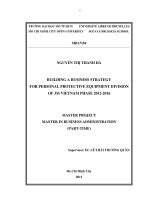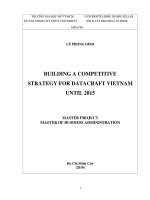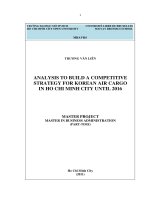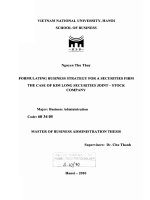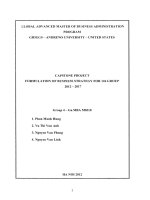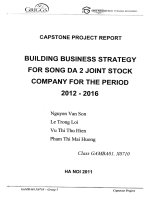Building a business strategy for Vietfund management until 2017
Bạn đang xem bản rút gọn của tài liệu. Xem và tải ngay bản đầy đủ của tài liệu tại đây (4.77 MB, 171 trang )
TRƯỜNG ĐẠI HỌC MỞ TP. HCM UNIVERSITÉ LIBRE DE BRUXELLES
HO CHI MINH CITY OPEN UNIVERSITY SOLVAY BRUSSELS SCHOOL
MBAVB4
TA NGOC PHUC
BUILDING A BUSINESS STRATEGY FOR
VIETFUND MANAGEMENT UNTIL 2017
MASTER PROJECT
MASTER IN BUSINESS ADMINISTRATION
(PART-TIME)
Tutor’s Name :Dr. NGUYEN MINH KIEU
Ho Chi Minh City
(2011)
i
COMMITMENT
I hereby, Ta Ngoc Phuc, committed my honesty for my thesis preparation and the
content was written by myself with information retrieved and obtained from reliable
sources. The information was re-produces from publication information and clearly
indicated with no plagiarism violation.
I also certify that the substance of this thesis has not already been submitted for any
degree and is not currently being submitted for any other degree or qualification.
Signature: HoChiMinh City
Ta Ngoc Phuc Date: December 2011
ii
ACKNOWLEDGEMENT
This thesis could not have been done without the inputs and contributions of many
people deserved to be named here. Firstly, my deepest gratitude goes to my Supervisor,
Dr. Nguyen Minh Kieu, who was always very dedicated, provided me with valuable
advices, recommendations throughout my thesis and his ceaseless encouragement helps
me to get through quickly and efficiently to the finish line. Furthermore, this thesis
would not be fully completed without the valuable knowledge that I comprehended
from the MBA program, Vietnam - Belgium in general, and from Strategy subject in
particular. My gratefulness also goes to all Solvay Professors from my MBA course and
to Prof. Georges Wanet who instructed me Strategy.
Secondly, I owe a debt acknowledgement to my boss, my mentor, Mr. Tran
Thanh Tan, C.E.O of Vietfund Management for inspiring me to go beyond ordinary
practice, knowledge, experiences and guide me from the first phase of company
strategy formulation.
I would particularly like to thank my colleagues in Investment and Research
division of VFM, Dragon Capital for their support related to data collection.
My sincere appreciation is extended Mr. Serge Bywaski, program coordinator of
Vietnam-Belgium program for his precious knowledge and great support throughout my
study in MBAVB4 course.
Specially, my sincere thanks go to my friends for their enthusiastic support for
this thesis and for their comments, reviewing, proposing corrections from the early stage
of my thesis. I would like to thank all persons who contributed one way or another to
this final result, thanks for their kindness, excellent support and willingness to share
their experiences and knowledge about fund management.
I, therefore, dedicate this work as a gift to them all.
iii
SUPERVISOR’S APPROVAL
I hereby certify that this thesis, submitted by Ms. Ta Ngoc Phuc, conforms to acceptance
standards and is fully adequate in scope and quality to fulfill this thesis requirements for
the degree of Master of Business Administration.
Supervisor Date
Dr. Nguyen Minh Kieu
v
EXECUTIVE SUMMARY
VietFund Management (VFM) is a pioneer and leader of local fund management
companies in Vietnam, offering a wide range of investment products and services.
VFM’s products fulfill the varying needs of both private and institutional investors
domestically and abroad.
Established in July, 2003 from an initial base of VND 8 billions (US$0.52m)
managed by 8 staffs, nowadays the total assets under VFM’s management are about
US$220 millions. VFM is managing 4 investment funds (3 of them have been listed in
Ho Chi Minh Stock Exchange) and providing discretionary investment portfolio
management for institutional and individual investors.
The always and ultimate goal of VFM is to maintain leading position in Fund
Management business in Vietnam profitably and sustainably. The total asset under
management (AUM) is the first and most important criterion to define the strength of a
FMC and affirm its leading position (as nearly 100% income of each FMC comes from
fund management fee). Hence, how VFM could increase its AUM in long term run is a
strategic question that the Company has to address. It’s not too difficult to define key
initiatives that have to take to hit the goal, which are: (a) fund raising; (b)investment
value; (c) acquisition or take over other funds.
But the important thing is what should be the right strategy to execute, especially
for the period 2012-2017 when overall economic conditions locally and globally are not
favorable to fund industry. In the context of Vietnam’s economic is still faced with
difficulties in general, Vietnam stock market is in industrial recession together with the
lack of legal framework… and still unable to find out strong foundation to recover, it is
realized that different industry face with different challenges. How to foster and
perform this goal with absolute professionalism and integrity, VFM needs to be driven
by an appropriate and challenging long-term strategy with the commitment to the
vi
sustainable development of the environment, society and economy of Vietnam. In the
such real currently situation of Vietnam stock market, how financial institutions, banks,
securities companies, FMCs can suffer, resist or survive is still an unsolvable issue. To
make business viable, sustainable, unscathed under financial crisis, to adapt challenges
to the growing use of environmental, social and governance investment criteria, to
capitalise on relevant trends…are major issues to financial investment companies target.
In search of a stable growth, VFM may find substantial growth, even seize in some
moment.
The thesis, therefore, digs deeply in analyzing the internal and external
environment of the company to figure out the most appropriate business strategy to
obtain company’s goal.
Base on key findings of the analysing secondary data, interviewing management
team and key staffs of Vietfund Management as well as other prominent Financial
Institutions, differentiation strategy is recommended to be suitable strategy for VFM to
pursue its business goal, especially for the period 2012-2017.
“If you're not faster than your competitor, you’re in a tenuous position, and if you’re
only half as fast, you’re terminal.” a notable quote of George Salk indicated a
successful company invest in planning strategy will help to establish a business
direction and focus on specific strategies and actions will improve performance. To
execute this, the firm focuses on indentifying and evaluating events beyond the
company’s immediate control. The company should know where it is, what its
competitors do, then do faster and faster in a prudent and smart way.
Every one knows that their company needs a strategy to move forward. But how
fast you find out your right strategy and execute it will decide the winner.
vii
TABLE OF CONTENTS
COMMITMENT i
ACKNOWLEDGEMENT ii
SUPERVISOR’S APPROVAL iii
COMMENTS FROM PROFESSIONAL MENTOR iv
EXECUTIVE SUMMARY v
TABLE OF CONTENTS vii
LIST OF ABBREVIATIONS xii
LIST OF TABLES xv
Chapter 1: INTRODUCTION 1
1.1. RATIONALE OF THE STUDY 1
1.2. PROBLEM STATEMENT 2
1.3. RESEARCH METHODOLOGY 3
1.3.1 Objectives 3
1.3.2 Research questions: 4
1.3.3 Data collection method 5
1.4. SCOPE, ASSUMPTIONS AND LIMITATIONS OF THE STUDY 6
1.5. DEFINITIONS OF TERMS USED IN THE STUDY 6
1.6. FRAMEWORK OF THE STUDY 9
Chapter 2:LITERATURE REVIEW 12
2.1. STRATEGY 12
2.2. STRATEGIC MANAGEMENT 15
2.3. STRATEGY ANLYSIS TOOLS 15
2.3.1 SWOT analysis: 16
2.3.2 PEST analysis: 17
viii
2.3.3 PORTER’S FIVE FORCES MODEL 17
2.3.4 Generic strategies to counter the five forces 18
2.3.5 PORTER’S generic strategies 20
2.4. STRATEGY FORMULATION PROCESS 23
2.4.1. Mission and vision 23
2.4.2. Environmental analysis 24
2.4.3. Strategy formulation and strategic choice: 25
2.4.4. Strategy implementation: 25
2.4.5. Evaluation and control 26
Chapter 3: EXTERNAL ENVIRONMENT ANALYSIS OF VIETFUND
MANAGEMENT 27
3.1 MACRO ENVIRONMENT ANALYSIS 27
3.1.1
Political, governmental and legal factors
27
3.1.1.1 Vietnam Political outlook:
27
3.1.1.2 Government’s policies
27
3.1.1.3
Legal condition towards new products development in Vietnam
28
3.1.2
Economic factors
28
3.1.2.1
Overview of the global economy:
29
3.1.2.2
Overview of Vietnam economy:
29
3.1.2.3
Vietnam enterprises operate under crisis:
30
3.1.2.4
A look into the future( period of 2011-2012 and to 2020):
31
3.1.3
Social, demographic and environmental factors
35
3.1.3.1
Vietnam individual and institutional investors’ trends and habits of investment
35
3.1.3.2
Investment obstacles in Vietnam
36
3.1.4
Technology
37
3.2 MICRO ENVIRONMENT ANALYSIS 38
3.2.1
Industry and market overview
38
3.2.1.1
Define the market:
38
ix
3.2.1.2 Role of Vietnam fund industry, its challenges and attractiveness :
47
3.2.2
Trends
66
3.2.3
Industry competitiveness and competitors analysis
72
3.2.3.1 Barriers of entry: low
72
3.2.3.2 Threat of substitute products: low to moderate
73
3.2.3.3 Bargaining power of buyers: low to moderate
73
3.2.3.4 Bargaining power of suppliers: low
74
3.2.3.5 Competitors analysis: moderate
74
3.3 SUMMARY OF COMPANY’S OPPORTUNITIES AND THREATS 76
3.3.1 Opportunities 76
3.3.2 Threats 77
Chapter 4: INTERNAL ENVIRONMENT ANALYSIS OF VIETFUND
MANAGEMENT 79
4.1. COMPANY’S PROFILE 79
4.1.1. Introduction of VFM’s Partners – Dragon Capital & Sacombank Group 79
4.1.2. Introduction of Vietfund Management: 81
4.1.3. Vision and Mission 82
4.2. ORGANIZATION STRUCTURE 82
4.2.1. Organization chart 82
4.2.2. Human resources 84
4.2.2.1. Human resource in financial industry 84
4.2.2.2. Human resource in VFM 85
4.3. BUSINESS OPERATION 85
4.3.1. Products & Services 85
4.3.1.1. Product: 86
4.3.1.2. Services 95
4.3.1.3. Product development trend: 96
4.3.1.4. Product development opportunity: 97
x
4.4. TARGET MARKET/ MARKET SEGMENTATION 98
4.4.1. Target market 98
4.4.1.1. Pension and open ended fund, a new track 101
4.4.1.2. Time for FMCs consolidation and close-ended fund is no longer a
favor 101
4.4.2. Target customers and segmentation: 102
4.5. BUSINESS OPERATION AND PERFORMANCE 104
4.5.1. Marketing 104
4.5.2. Finance 105
4.5.3. Business Development 106
4.5.4. Investment 106
4.5.5. Trading 107
4.5.6. Research and Analyst 107
4.5.7. Back office 108
4.5.8. Risk management 108
4.6. VIETFUND MANAGEMENT STRENGTHS AND WEAKNESSES 108
4.6.1. Strength 108
4.6.2. Weakness 110
Chapter 5: DEVELOPING AND FORMULATING STRATEGY FOR VIETFUND
MANAGEMENT 112
5.1. REDIFINING COMPANY’S MISSION AND VISSION 112
5.2. SWOT ANALYSIS 113
5.3. SWOT strategies 117
5.4. KEY SUCCESS FACTORS 120
5.5. VFM POSITIONING TO MARKET UNTIL 2017 121
5.6. SHORT TERM AND LONG TERM STRATEGY FORMULATION 121
5.7. STRATEGY IMPLEMENTATION 122
xi
CONCLUSIONS AND RECOMMENDATIONS 138
APPENDIX I QUESTIONAIRE (ENGLISH VERSION) I
APPENDIX II – COMMON TERMS AND DEFINITIONS VII
APPENDIX III - GOVERNMENT BODIES XI
APPENDIX IV- WEBSITE FOR VIETNAM STOCK MARKET XII
xii
LIST OF ABBREVIATIONS
FMCs Fund Management companies
VFM
Vietfund Management
HOSE Ho Chi Minh Stock Exchange
HNX Hanoi Stock Exchange
SSC State Securities Commission
NAV Net Asset Value
OTC
Over The Counter or Off-exchange trading
(to trade financial instruments as stocks, bonds,
commodities…)
WTO
World Trade Organization
AUM Asset Under Management
SMEs Small and Medium Enterprises
GDP
Gross Domestic Product
EU European Union
FDI Foreign Direct Investment
SOEs
State Owned Enter
prises
CPI Consumer Price Index
F/X market Foreign Exchange market
VCCI
Vietnam Chamber of Commerce and Industry
Q1, Q2 Quarter 1, Quarter 2
CAGR Compound Annual Growth Rate
MOF Ministry of Finance
UNDP United Nations Development Program
ESOP Employee Stock Ownership Plan
xiii
LIST OF FIGURES
Figure 1.1 Framework of the study 10
Figure 1.2 Framework of the study 10
Figure 2.1 Framework for strategic management 15
Figure 2.2 SWOT Analysis Framework 16
Figure 2.3 Diagram of Porter’s 5 Forces 19
Figure 2.4 The strategic planning process 23
Figure 2.5 Mission and vision 24
Figure 2.6 Strategy Formulation 25
Figure 3.1 Vietnam nominal GDP from 1993-2009, Source HSBC 32
Figure 3.2 Vietnam GDP per capita vs. Developing Asia (USD) from 2000-2009 33
Figure 3.3 Investment obstacles in Vietnam 37
Figure 3.4 The Ho Chi Minh Index from 2000 – Jan 2010 40
Figure 3.5 Emerging and frontier markets comparison 40
Figure 3.6 VN Index and trading volume 41
Figure 3.7 Market performance from 2005 – 2011 with special events 41
Figure 3.8 Market share of listed funds managed by Vietfund Management in Vietnam
on both Hose and Hnx 44
Figure 3.9 Total trading volume of VNI vs. total trading volume of all public funds 47
Figure 3.10 Listed stocks, bonds and fund certificates from 2007-2010, Hose 50
Figure 3.11 Nominal GDP per capita 50
Figure 3.12 The NAV discount, Vietnam vs. other countries from Feb 2010 to Sep 2011
52
Figure 3.13 Percentage of investors react with fund during glooming time 57
Figure 3.14 Trading Price, Discount vs. NAV 58
Figure 3.15 Large market and historical high discounts to NAV, Vietnam-India and
China 59
xiv
Figure 3.16 Total of fund with ending term and its capital 63
Figure 3.17 Market dominated by financial institutions 68
Figure 3.18 Vietnam GDP vs. other Asia countries 69
Figure 3.19 Fees incurred by Stock and Bond Mutual fund declined since 1990 71
Figure 4.1 VFM Company organization chart 83
Figure 4.2 VFM Product and Services 86
Figure 4.3 VFMVF1 on Bloomberg news 87
Figure 4.4 VFMV1, NAV performance 89
Figure 4.5 VFMVF2, NAV Performance 90
Figure 4.6 VFMVF4, NAV Performance 92
Figure 4.7 VFMVFA, NAV Performance 94
Figure 4.8 VFM, Discretionary portfolio management service 95
Figure 4.9 VFM is on going stable growth (2003-2011) 96
Figure 4.10 Vietnam Social Security Fund payment 99
Figure 4.11 Total saving on GDP in Vietnam 100
Figure 4.12 Vietnam Gold Reserve 100
Figure 4.13 Vietnam Population Pyramid 100
Figure 4.14 Vietnam & Foreigner investor volume in 2007 vs. 2010, 2011 of VFx 102
Figure 4.15 VFx, Investor regional segmentation in 2007 and 2010 103
Figure 4.16 VFx, Investors analyzing in 2007 and 2010 103
Figure 4.17, Fund certificate own percentage in 2007 and 2010 103
Figure 5.1 Japan market share in 1990-2010 127
Figure 5.2 Internet penetration in selected Asian countries 134
Figure 5.3 Internet use growth 200—2010 in selected Asian countries 134
xv
LIST OF TABLES
Table 2.1Porter’s Generic Strategies 20
Table 3.1 Vietnam’s P/E ratio and others ratio comparison with other countries 30
Table 3.2 VnExpress survey on investors’ investment channel 36
Table 3.3 Vietnam Stock market and its figure 39
Table 3.4 Vietnam funds’ milestone 43
Table 3.5 Total of local FMCs and local funds in operation 43
Table 3.6 Information related to Vietnam Investment fund certificate listed 44
Table 3.7 Total number of local funds in operation and initial raised capital 45
Table 3.8 Discount rate in Vietnam, updated at August 2010 53
Table 3.9 NAV of Vinacapital at November 2011, according to Vinacapital source 56
Table 3.10 Current listing scale 67
Table 3.11 The market capitalization value (VND trillion) 68
Table 3.12 List of upcoming listings and IPOs 70
Table 4.1 Personnel status at securities companies in general 84
Table 4.2 Vietnamese funds, top 10 most liquid one 88
Table 4.3 VF1, Movement in NAV at 31June 2011 88
Table 4.4 VFMVF4, Movement in NAV 91
Table 4.5 VFMVFA, Movement in NAV 94
Table 4.6 Vietfund Management Financial Performance from 2003-1011 105
Table 5.1 SWOT analysis 113
Table 5.2 Industry statistics from 1998-2007 125
Table 5.3 VFM’s AUM projection 2012-2015 127
Table 5.4 Result of NAV before and after buy back plan in 2010 128
1
Chapter 1: INTRODUCTION
“ It takes 20 years to build a reputation and five minutes to ruin it. If you think about
that, you’ll do things differently”. A famous saying of Warren Buffet has pointed out
how important for a company to build up the right business strategy, how do it
implement monitor and adjust, how necessary do we need to evaluate and control it…As
if the company does not take enough consideration and prudence on this matter, it will
lose and lack direction and be unable to obtain targets. Those what the company built up
might be destroyed in a short time.
1.1. RATIONALE OF THE STUDY
Profitability is the only reliable measure of the economic value of a company. How to
generate more profit, to preserve the asset, the arduous value obtained during the last 8
years and uphold the growth, VFM must engage in strategic planning that clearly
defines objectives and assesses both the internal and external situation to formulate the
]strategy appropriately, implement it effectively and professionally then evaluate the
progress, and make adjustments as basic necessities to stay on track.
In the context of severe, unprecedented financial instability, survival and
maintain the operation of the company, seems to be unachievable mission of FMCs in
Vietnam. According to Dau tu chung khoan, 6 August 2011, “… some close-ended funds
will end up their fund term after 5-7 years operation. The prospect of Vietnam stock
market is still grey and uncertain, Vietnam domestic investment funds with NAV’s
discounted unable to raise any other new fund. Hence, the current funds will be
terminated, new fund can not be established, domestic fund industry is predicted to be
vanished soon…”.
Vietnam fund management industry is considered as one of the most important
sectors of the economy, to lever effect the development of many others economic
industry. However, the state of the fund management industry in Vietnam has not been
2
identified its value properly, lack of attention and has never been received favourable
from government authorities. Developing the Vietnam fund industry in general calls for
more concerns of active well-performed knowledgeable authorities to construct a long
term strategy operating in a stable healthy stock market.
Investment managers that enjoy long-term success are increasingly
differentiated from those that struggle to survive or even collapse by the strength of
their marketing efforts: a solid marketing, sales and client relations team able to
execute a well-constructed strategic plan.
To prepare ahead for rapid change in the Vietnam financial market, to keep tract
with the new trends of many other fund industries in emerging markets, developing
markets, to continue the pioneering FMC in Vietnam, VFM not only build a developing
strategy but also need a comprehensive insight on external, internal issues reciprocal
impact to VFM’s business, thence each heading will be more prudent, smart, strategic,
professional and effectively.
Rudyard Kipling (English, short-story writer, poet, and novelist. Nobel Prize),
told his countrymen, “If you can keep your wits about you while all others are losing
theirs, and blaming you The world will be yours and everything in it”. It is obviously
that if a company can survive during crisis period while others are in flopping status or
fail, that company will have it all.
1.2. PROBLEM STATEMENT
“To be or not to be that is the question; Whether ‘tis nobler in the mind to suffer”. A
notable quote of Hamlet act three, scene one, William Shakespeare, 1600 AD, is
consider as a strategic question for FMCs during this period.
Following the global financial crisis, 2011 is such a glooming year to all
enterprises, especially to the financial institutions, local and foreign investment funds
operating in the fluctuation of micro economic and the significant decrease of the
capital market. The investment management industry, especially the investment fund is
intensively competitive crowded with firms offering comparable investment
3
capabilities, philosophies and expertise. Building a wise, insight, detailed business
strategy is a key driver of long term success in the market.
Success hurdles are included in all plans, which can be measured against a range
of factors including payback period and net present value. To accommodate the
unpredictable markets, business strategy must be directional not precise; dynamic not
static. Business strategy serves as a map, with built-in flexibility for continuous
recalibration. The downtrend of the stock market had a strong impact on the operation
of FMCs in general and on the business that VFM is running in particular, specifically
in:
Net asset value of all the funds managed by VFM were extremely discounted
against the trading price in comparison to 2010.
All investors neglected in investing in stock markets, neither listed stocks nor OTC
stocks were lacked of investors’ interest. Fund certificates are ignored much more
and being traded less and its liquidation has dropped considerably.
The design and developing of new products met difficulties arising from the
obstacles related to the legal framework and the favorable market conditions.
If the above problems can not be solved, VFM might have difficulties in the fierce
competition among other strong competitors and the leading position seems tough to
control.
The thesis will go overall and deep analyze the external environment including
macro and micro factors in which VFM is in to figure out the opportunities and threats,
then applying Michael Porter’s five forces model to have a closer approach to the
company’s strengths and weaknesses and summarizes in the SWOT analysis. Based on
theses findings and trials, the most suitable and appropriate strategy will be chosen.
1.3. RESEARCH METHODOLOGY
1.3.1 Objectives
The research objective is a precise statement of what information is needed. It consists
of an identified application, the research question(s), the hypotheses, and the scope (or
4
boundaries) of the research(Aaker et al 2001). The purpose of this thesis is clearly
established. How to develop a business strategy for the company to pursue a long term
success in the market. This objective can be achieved by the following specific
objectives:
To understand clearly and deeply the external and internal environment of the
company.
To understand clearly the actual state of the fund industry and the market trend.
To overall analyze the Vietnam fund industry and FMCs’ operation, including
opportunities, challenges, obstacles and attractiveness.
To analyze the current status of the company and what the company would like to be
under the severe condition.
Finally for the thesis is to determine and choose the strategic direction for the
development.
1.3.2 Research questions:
According to Zikmund (1997), research questions involve the research translation of
“problem” into the need for inquiry. The research problem defined above leads to the
following research questions. Research questions are statements describing exactly
what the research report should answer. The research questions of this thesis are as
followings:
What are the external and internal factors affecting VFM’s business? (answered in
chapter 3 and 4)
What are challenges and difficulties of the Vietnam stock market in general and
Vietnam fund industry in particular ? (answered in chapter 3)
What is the status quo of the Vietnam fund industry and FMCs? (answered in
chapter 3 and 4)
What are the big issues of VFM in terms of business management and orientation?
(answered in chapter 3 and 4)
5
How to build up an appropriate business strategy for VFM until 2017? What kind of
strategy should VFM develop for business growth? ? (answered in chapter 5 and 6)
1.3.3 Data collection method
This research uses weekly stock market data between 2002- 2009 from DataStream and
emerging market fund data from Emerging Portfolio Fund Research Inc (EPFR).
Theoretical Data – Secondary Data
The theoretical data is mainly derived from books and articles, from which we have
collected the information constituting the theoretical framework for the master thesis.
This is the already developed information on the topic and the theoretical framework is
a result of our extensive research on corporate environmental strategy and other topics
closely related to. We found it necessary to look into these topics as well, due to their
connection and co-dependencies, but we have remained at the core, that is corporate
environmental strategy. The surrounding topics have increased our knowledge base and
given us a good understanding of the complexity businesses have to deal with today.
The theoretical knowledge has also been of importance in the creation of questions for
the interviews. We wanted to make sure that we would ask the “right” questions, but
also be able to understand, interpret and analyze the information , according to Kvale,
(1997).
Secondary data collection is conducted by retrieving from VFM performance
data, VFM’s portal, and all information on fund industry, VFM’s competitors related to
the study. Vietnam financial articles, newspapers, magazines, internet websites, other
information from reliable resources… were also utilized and examined to provide a
deeper comprehension of how the market goes, what competitors do… Foreign reports,
special reports, annual updated, fact books, statistical research and survey provide a
broad overview of the investment landscape about global stock market performance,
development in general.
Primary data is collected mostly through in-depth interview with company’s
executive managers, professional analysts, outsiders’ executive directors from big
6
financial institutions and do the questionnaire survey. The questionnaire is designed to
find out the information related to the market trend, investors’ behavior, product…This
qualitative method is applied to find out the honesty as well as the quality of the study.
The insight and interesting inputs of VFM Board of Director, analysts… has contributed
to the success of this thesis.
1.4. SCOPE, ASSUMPTIONS AND LIMITATIONS OF THE STUDY
Vietnam stock market in general is still young and not mature in comparison with others
in regional and the size and scale of Vietnam fund industry is not worth considering in
particular. The collection and gathering information related for this study is quite hard
and limited. The amount of FMCs is also small in size and insignificant, so that data are
not shown on the surveys and reports of many big and prestige financial institutions.
There is limited information about competitors such as profits, market shares, strengths,
weakness…
The study applied strategic management theories and its literature review of
PEST framework, Porter’s five forces models, SWOT framework in order to achieve
the objectives of the study.
1.5. DEFINITIONS OF TERMS USED IN THE STUDY
Specialized terms used in this study include AUM, investment fund, close ended fund,
open ended fund, Fund management company, financial management.
What is a securities investment fund?
A securities investment fund is a fund that invests in the assets listed in the following:
(1) securities as defined in Article 2.1 of Decree 48; (2) stocks and bonds issued by
unlisted companies; (3) government bonds, convertible bonds, bonds with warrants,
depository receipts; (4) money market instruments such as commercial papers and
negotiable certificates of deposit; and (5) others debts by the State Securities
Commission (SSC).
In general, investment fund is the pool of money contributed by a range of
investors who may be individuals or companies or other organizations, which is
7
managed and invested as a whole, on behalf of those investors. This investment fund is
professionally managed by the fund management company and closely monitored by
the regulators.
What is a Fund Management company?
Fund management company is a type of the financial intermediary institution,
dedicated to establish and manage investment funds, serve the need of medium and
long term investment of investors. In Vietnam, FMC is licensed and monitored by SSC.
Financial management is concerned with all areas of management which involve
finance – not only the sources and uses of finance in the enterprise, but also the
financial implications of investment, production, marketing or personnel decisions and
the total performance of the enterprise (Meredith, 1986). Financial management is
concerned with raising the funds needed to finance the enterprise’s assets and activities,
the allocation of these scarce funds between competing uses, and ensuring that the
funds are used effectively and efficiently in achieving the enterprise’s goals
(McMahon, Holmes, Hutchinson and Forsaith, 1993). However, financial management,
in this study, is limited to a framework of five specific areas: (1) accounting information
system (2) financial reporting and analysis, (3) working capital management, (4) fixed
asset management, and (5) capital structure management. This limitation is necessary
and appropriate to financial management practices of SMEs in Vietnam, given
information available for research.
Assets under management or AUM is a type of financial service which is used
to estimate and approximate the money involved in an investment. Most of the financial
services establishments utilize this technique to measure their success rate. Financial
establishments normally use this assets under management service to judge their the
amount of money they are managing through investment management, money
management and mutual funds. Financial companies compare their success rate with
other financial establishments and while doing this they use assets under management
instead of revenue.
8
Assets under management (AUM) is a financial term used by those within the
financial services industry such as mutual funds, hedge funds, private equity funds,
money management, investment management, wealth management, and private
banking businesses as a measurement of how much money they are managing. It is
sometimes used as a yardstick for success and for comparison of companies within an
industry. Asset under management balances consist of market performance
gains/(losses), foreign exchanges movements, net new assets (NNA) inflow/(outflow),
and structural effects of the company, such as acquisitions.
Investors may also interested in the NNA (sometimes called net new money or
NNM), which indicates how much client money has been newly invested. Client assets
are transactional assets, which are used as collateral for specific transactions, e.g.
margin accounts. It is common to calculate the key figure NNA growth, which shows the
NNA in relation of the previous AUM balance on an annualized basis. NNA growth can
also be referred to as organic growth.
What Is a Close-Ended Fund?
According to 2011 Investment company fact book, A close-end fund is a type of
investment company whose shares are listed on a stock exchange or traded in the over-
the-counter market
. The assets of a close-ended fund are professionally managed in
accordance with the fund’s investment objectives and policies, and may be invested in
stocks, bonds, and other securities
. The market price of close-ended fund shares
fluctuates like that of other publicly traded securities and is determined by supply and
demand in the marketplace.
Close-ended funds offer a fixed number of shares to investors during an initial
public offering. Close-ended funds also may make subsequent public offerings of shares
in order to raise additional capital
. Once issued, the shares of a close-ended fund are not
typically purchased or redeemed directly by the fund. Rather, they are bought and sold
by investors in the open market.
9
Because a close-ended fund does not need to maintain cash reserves or sell
securities to meet redemptions, the fund has the flexibility to invest in less liquid
portfolio securities. For example, a close-ended fund may invest in securities of very
small companies, municipal bonds that are not widely traded, or securities traded in
countries that do not have fully developed securities markets. Close-ended funds also
have flexibility to borrow against their assets, allowing them to use leverage as part of
their investment strategy.
Close-Ended Fund Pricing
Many close-ended funds calculate the value of their portfolios every business day,
while others calculate their portfolio values weekly or on some other basis. The net
asset value (NAV ) of a close-ended fund is calculated by subtracting the fund’s
liabilities (e.g., fund expenses) from the current market value of its assets and dividing
by the total number of shares outstanding. The NAV changes as the total value of the
underlying portfolio securities rises or falls.
Because a close-ended fund’s shares trade in the stock market based on investor
demand, the fund may trade at a price higher or lower than its NAV . For example, a
close-ended fund in great demand may trade at a share price higher than its NAV. In
this case, the fund’s shares are said to be selling at a “premium” to the NAV.
Conversely, a closed-end fund trading at a share price lower than its NAV is said to be
selling at a “discount”.
1.6. FRAMEWORK OF THE STUDY
The study is conducted based on the strategy formulation process. Firstly, the external
environment is analyzed to figure out opportunities and threats. Then every aspect of
the internal environment is scanned and audited to identify factors related to strengths
and weaknesses of the company. Finally, an appropriate business strategy is formulated.
Detailed recommendation for the implementation of the business strategy and
evaluation after that. Figure 1.2 illustrates the structure of the study framework.
Strategic planning process is shown by the following diagram:
10
Figure 1.1 Framework of the study
Or, strategic management process has three main components, shown in the figure 1.2
below:
Figure 1.2 Framework of the study
The study is organized as follows:
Chapter 1 – Introduction.
This chapter introduces about the rationale of the study, problem statement, objectives
of the study, research methodology, definitions of terms used in the study, how the study
is carried out and what is the scope and limitations.
Chapter 2 – Literature review.
This chapter briefly presents the theories and models that will be used in the study,
including theory of strategy management, strategy components, strategy hierarchy,
